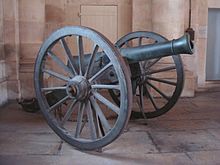


The Canon-obusier (literally "Shell-gun cannon", "gun-howitzer") was a type of cannon developed by France in the 1850s. The canon-obusier was a smoothbore cannon using either explosive shells, solid shot, or canister, and was therefore a vast improvement over previous cannon firing only solid and canister shot, such as the Gribeauval system.
The very first canon-obusiers were naval shell guns, invented in 1823 by Henri-Joseph Paixhans and introduced in the French Navy in 1842. This invention was related to the origin of the development of the Dahlgren shell gun in the United States in 1849.
The French Army introduced the canon-obusier de 12 in 1853. The US version of this type of canon-obusier, commonly called the "12-pounder Napoleon Model 1857", was one of the most-used cannon in the American Civil War. Over 1,100 of these "Napoleons" were manufactured by the Union, and 600 by the Confederacy.
The canon-obusier de 12 followed rifled cannon of the Treuille de Beaulieu system which had been introduced in 1858.
The term "Canon-obusier" remained in use after World War I to designate various gun howitzers of the French Army.
See also
References
- A Treatise on Naval Gunnery By Howard Douglas p.432
- The Mitrailleuse by Dr. Patrick Marder Military History Online
- Nps.gov
- Nps.gov
- "...the introduction by the French army of the Beaulieu 4-pounder rifled field-gun in 1858: the new artillery, though much more accurate and long-ranged than the smoothbore 'canon-obusier' it replaced (which, incidentally, was the most prevalent artillery piece of the US Civil War), was not suited to firing anti-personnel case-shot (which, in French, is called 'mitraille')." in The Mitrailleuse by Dr. Patrick Marder Military History Online
| Small arms | ||
|---|---|---|
| Machine guns | ||
| Cannons | ||
| Warships | ||
| Ammunition | ||
| Systems | ||
| Operational usage | ||
